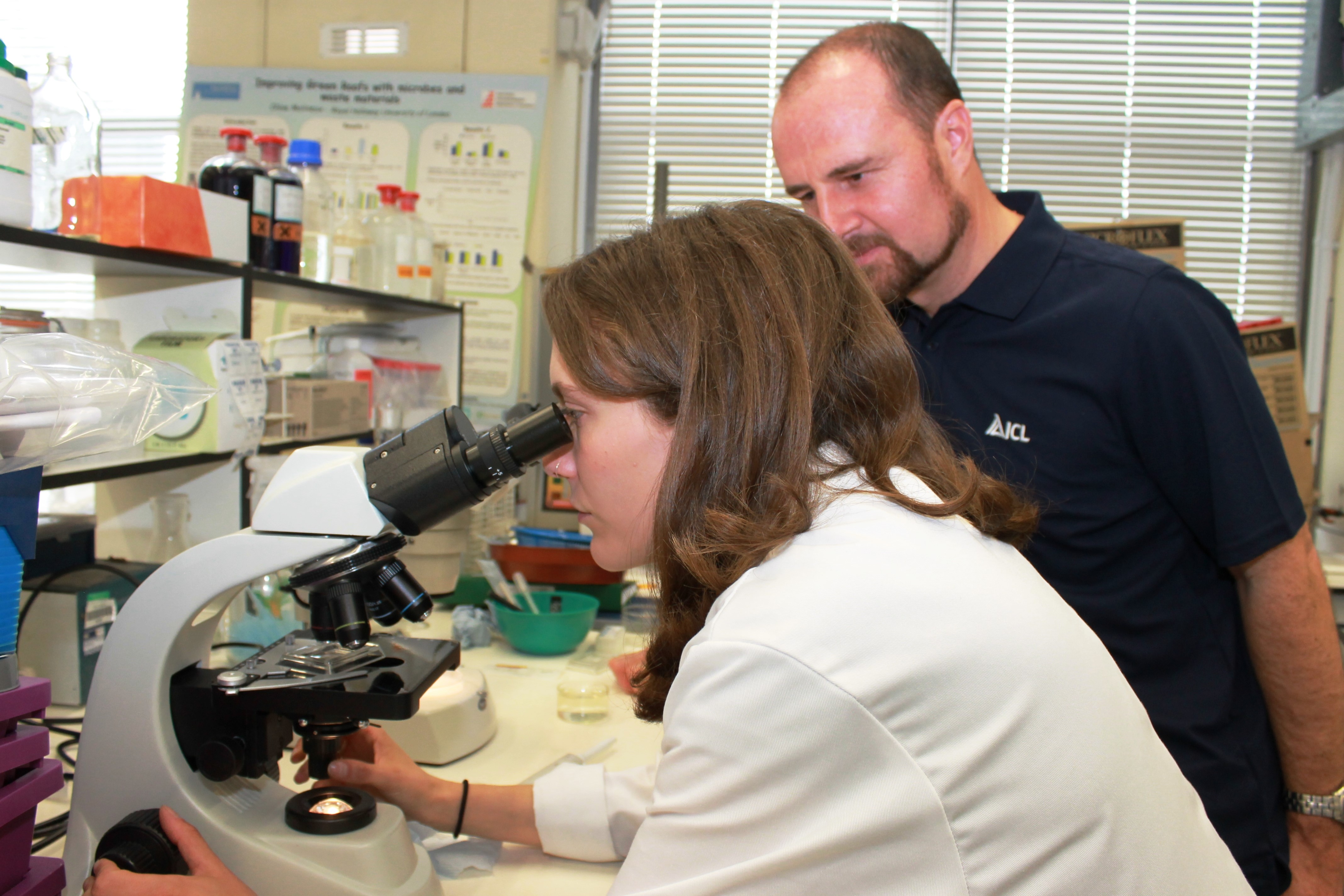Could seaweed help keep nematodes in turf grass in check?
More and more greenkeepers are talking about problems with parasitic nematodes affecting their turf. Seaweed could provide a sustainable, novel solution for reducing plant-parasitic nematodes in turf grass.
Without previous extended research into this subject, Royal Holloway (University of London) and ICL joined forces in 2018 for a four-year PhD research project thanks to funding from the BBSRC (Biotechnology and Biological Sciences Research Council) and ICL. Halfway through now, we spoke to Tamsin Williams, the PhD student working on the research project to find out how it is going.

Tamsin completed her undergraduate degree in Biology at Royal Holloway, University of London. The degree was broad, looking at everything from biomedical sciences to field ecology. After passing her undergraduate degree, Tamsin worked at CABI (Centre for Agriculture and Bioscience International) as a research assistant in the bio-pesticides division. CABI is primarily a non-profit organization working a lot with agriculture in developing countries, helping small subsistence farmers.
“We were trying to develop mainly fungal bio-pesticides to help improve crop yields, for example, but also many other projects. And to develop products that are environmentally friendly and sustainable and could be used by small-stakeholder farmers abroad, as well as in the UK. From that I went straight to my PhD. While I was at CABI, I was also doing a lot of pest pathology and a bit of Nematology (study of nematode worms). My PhD has an element of Nematology and nematode identification which is a direct link and this is a subject I find interesting and enjoy, which helps!”
An important research topic for the Turf industry
There are multiple reasons why Tamsin’s PhD research is important. “One is plant parasitic nematodes seem to be on the increase: this could be due to environmental factors, so as we get warmer temperatures we’ll get warmer soil temperatures, and when the soil temperature is warmer we generally get this faster cycling of the nematode life cycle. The time between laying their eggs and hatching will be shorter. When this occurs, you’ll get these big population booms in nematode numbers, because they’re hatching a lot quicker. Potentially we’re seeing greater numbers of nematode infections and turf damage, but also coinciding with that is that there are virtually no available chemicals (nematicides) for amenity turf. So, there are very few options available to control an increasing population. We’re trying to find something that people can use, that works, whilst not harming the environment and is sustainable.”
The problem with nematodes
Nematodes are tiny microscopic parasitic worms. “They pose a problem, because they parasitize the plants, some of them complete part of their lifecycles inside the plants themselves, they can hijack the plant’s machinery to make it work for them (…which is quite clever, really…).” When nematodes feed on the plant or when they move inside the plant, they cause a lot of cell death. This cell death will accumulate, which is when you get the visual symptoms that you might see on the playing surface, the pitch or golf green, where you get yellowing and turf wilting. Eventually the plant may even die.
Tamsin: “So that is not ideal when you’re trying to manage a turf surface (or a commercial crop). There will be nematodes in the soils of a golf green or sports field at all times, and not only plant parasitic nematodes, there are also scavenger nematodes that might feed on bacteria and fungi, as well as cannibalistic nematodes, so there’s a whole range of them. Plants can withstand a bit of nematode feeding from some of the nematodes, but it’s when the numbers are too high, that you start to see the visual symptoms. And the visual symptoms will only occur once the nematodes have started attacking, essentially. With few products available to use, an integrated approach utilizing cultural practices and maintaining soil and plant health is definitely the key.”
Seaweeds as part of sustainable integrated pest management
That is where seaweeds may come into play. Seaweeds are complex. They have evolved to survive in quite harsh and changing conditions, cold salty sea, being up on the beach, perhaps drying out as well. To deal with these completely different environments, seaweeds have a range of unique complex carbohydrates and proteins. It is thought that some of the compounds can ‘kick-start’ the plant’s own resistance to pest attack.
Different seaweeds extracted in different ways will contain different components, so expect the plant response to vary. Tamsin: “I am studying the ICL seaweed product SeaMax from Acadian. This is an alkaline extracted Ascophylum nososum seaweed, which has already got some impressive research published on its benefits to crops. Since the start of the PhD in 2018, we’ve seen from some controlled laboratory trials that this seaweed may be able to reduce abundances of one type of plant-parasitic nematode, which is the spiral nematode. But this is only when starting nematode population density is quite high, so good results depend on nematode density as well as nematode species.”
But even if the seaweed only potentially reduces those high numbers when there’s big population booms, that would still be valuable to the turf manager. Tamsin explains: “This effect has also been seen in field trials, which are at their early stage. The results are not due to any form of nematocidal effect, so the seaweed does not kill the nematode directly, we have done a series of lab assays checking this. So it must be affecting their populations indirectly through some sort of plant modulation or modulating the soil microbiology.”
Next, Tamsin will be looking for this underlying mode of action as well as fine tuning the field trials to try and get more dramatic results for more nematode species. “Basically, what the seaweed may be doing to the plant itself and the microbial ecology in the soil, as this is ultimately how it’s going to be affecting the nematode.”
 Pictured: Tamsin and one of her two supervisors, ICL’s Turf International Technical Manager, Andy Owen
Pictured: Tamsin and one of her two supervisors, ICL’s Turf International Technical Manager, Andy Owen
Executing the field experiments is a laborious task that takes about two weeks to set up. That time is used to take initial samples to check nematode pressure and do counts from those samples. Then the trial itself will run for about three months. Tamsin: “Then at the end of three months I’ll take my final counts, that means taking the samples and literally counting them one by one under a microscope. Including everything else that I’ll be doing, it’ll take me a month until I have the final nematode counts and pop it in the statistics package so probably about four to five months. In a year you’re looking at maybe two field trials.”
At the end of her four-year project, Tamsin would like to be able to give a greenkeeper or groundsman tips when it comes to parasitic nematode management. “I’d like to get to the end of it and say, here’s some sort of sustainable and environmentally-friendly integrated pest management that you could use on your greens. That’s probably quite ambitious, but something along those lines!” The outcomes of Tamsin’s research will provide valuable scientific support for ICL’s further research and development in seaweed products.
Not a day is the same
With about half of the project to go, Tamsin still has lots to do. As the coronavirus outbreak has hit Europe in the past weeks and months, the university is currently closed and Tamsin works from home. “Most of my work is now on hold, with no experiments or field trials currently taking place, and I will not be able to continue until after lockdown. At home my focus is primarily on a meta analysis. Normally, my days are different all the time. Every experiment is different, so you can have days focused on reading published papers, days spent in the lab working on an experiment, time looking down a microscope identifying individual nematodes or counting mycorrhizal infection, and days in the field setting out and running field trials, perhaps all these in a single day! Then generally I’ll be looking after things like my nematode cultures, so constantly having to keep them in plants, refresh them, look after them. They’re like my nematode babies… As I progress, I will need to focus more on writing and analyzing the results which can be quite complex.”
A PhD is definitely not only laboratory work and Tamsin says it has given her the opportunity to learn new skills, invaluable to any researcher. “Firstly, how to come up with ideas and problem-solving. Developing presenting skills, which is an ongoing process, and also specific skills like statistics and field trial skills. I like the hands-on stuff, but the PhD has taught me how to actually get behind my computer, do the maths, and work with new programs that I hadn’t worked with before.”
Towards greener research
In the future, Tamsin would like to stay in science and perhaps even research in some way, whether that is academical or commercial. “It’s good how ICL are looking to support and fund research. As I’m aware not many other companies seem to do that. I think it’s very important to have trial work and science to back up product claims that you are making. This gives products credibility and an end-user confidence when selecting products to use.”
“ICL are looking to fund more green technologies, so PhDs that look at sustainable products or alternatives. There is another research project being funded that is looking at saving water on sports surfaces, and another that is looking at recycled phosphorus, which is very impressive: stripping nutrients from waste water and turning it into fertilizer. ICL is moving towards a greener research.”

